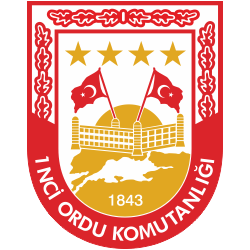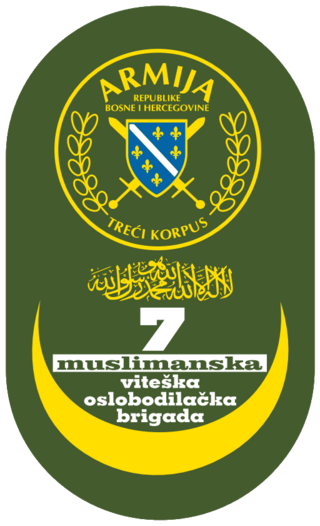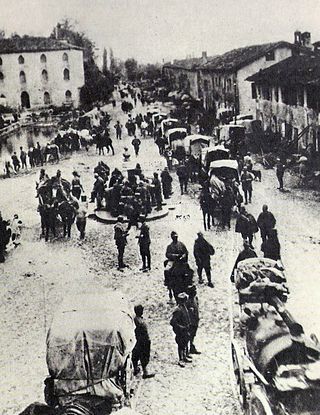
I Corps was an army corps in existence as an active formation in the British Army for most of the 80 years from its creation in the First World War until the end of the Cold War, longer than any other corps. It had a short-lived precursor during the Waterloo Campaign. It served as the operational component of the British Army of the Rhine during the Cold War, and was tasked with defending West Germany.

The Implementation Force (IFOR) was a NATO-led multinational peace enforcement force in Bosnia and Herzegovina under a one-year mandate from 20 December 1995 to 20 December 1996 under the codename Operation Joint Endeavour.

The First Army of the Republic of Turkey is one of the four field armies of the Turkish Army. Its headquarters is located at Selimiye Barracks in Istanbul. It guards the sensitive borders of Turkey with Greece and Bulgaria, including the straits Bosporus and Dardanelles. The First Army is stationed in East Thrace.
The order of battle for the Battle of France details the hierarchy of the major combatant forces in the Battle of France in May 1940.

Radislav Krstić is a former Bosnian Serb Deputy Commander and later Chief of Staff of the Drina Corps of the Army of Republika Srpska from October 1994 until 12 July 1995. He was promoted to the rank of major general in June 1995 and assumed command of the Drina Corps on 13 July 1995.

The Army of the Republic of Bosnia and Herzegovina, often referred to as Bosnian Army or Bosniak Army, was the military force of the Republic of Bosnia and Herzegovina. It was established by the government of the Republic of Bosnia and Herzegovina in 1992 following the outbreak of the Bosnian War.

The Croatian Defence Council was the official military formation of the Croatian Republic of Herzeg-Bosnia, an unrecognized state that existed in the Republic of Bosnia and Herzegovina between 1991 and 1996. The HVO was the main military force of the Croats of Bosnia and Herzegovina.

The 7th Muslim brigade was an elite all-volunteer brigade of the 3rd Corps of the Army of the Republic of Bosnia and Herzegovina. It served as the ARBiH's primary assault brigade in Central Bosnia, and was headquartered in Zenica. The brigade's manpower largely came from the cities of Zenica, Travnik, and Kakanj; however, there were soldiers from all over Bosnia who served in its ranks. During the war, the brigade liberated over 1,100 km2 of territory, including multiple cities, as well as numerous villages and mountains. Some of the most notable combat actions of the 7th Muslim brigade include the liberation of Vareš, Fojnica, Bugojno, Kakanj, and Travnik from the hands of HVO forces, as well as the defence of Mt. Igman and the liberation of liberation of Mt. Vlašić (Opaljenik), Teslić-Šerić (Jezera), Nabožić (Ilijaš), and Vozuća and the Ozren pocket from VRS forces.

The 5th Corps was one of seven corps of the Army of the Republic of Bosnia and Herzegovina. The formation was around the Bihać pocket to protect it against the surrounding Serb forces. The Fifth Corps also fought secessional Bosniak forces loyal to Fikret Abdić, who was cooperating with Serb forces. In the last military action of the ARBiH, Operation Sana, the corps defeated Abdić's supporters and brought a number of regions of Bosnia and Herzegovina under government control. In April 2018, police detained Atif Dudaković and 12 others on suspicion of committing crimes against humanity during the Bosnian war. The court process is still ongoing.

This section is about the history of the Army of the Republic of Bosnia and Herzegovina that existed from 1992 to 1995, then it was formed into two armies of the two entities from 1998 to 2005 and finally transformed into the Armed Forces of Bosnia and Herzegovina (OSBIH).

Državna Tajna is a book by Semir Halilović, son of Bosnian general Sefer Halilović, published in 2005. The book has the tagline "STROGO POVJERLJIVO"

The 3rd Corps of the Army of the Republic of Bosnia and Herzegovina was one of five corps that comprised the Army of the Republic of Bosnia and Herzegovina. It was established by the order of the Commander of Main Staff of the Bosnian Army Sefer Halilović on 9 November 1992 under Alija Izetbegović. This Corps was formed to unite the rest of the Territorial Defence Force of the Republic of Bosnia and Hercegovina and some Bosnian Special Forces and Civilian Forces.

The 2nd Corps was one of five, later seven corps in the Army of the Republic of Bosnia and Herzegovina established in early 1992.

The 6th Corps was a corps of the Army of the Republic of Bosnia and Herzegovina.

The Battle of Caporetto, took place from 24 October to 19 November 1917, near the town of Kobarid, on the Austro-Italian front of World War I. The battle was named after the Italian name of the town of Kobarid.
The Battle of Kupres was a battle of the Bosnian War, fought between the Bosnian Croat Territorial Defence Force supported by the Croatian Army troops on one side and the Yugoslav People's Army, augmented by the Bosnian Serb TO on the other at the Kupres Plateau, on 3–11 April 1992. During the fighting on 8 April, the Bosnian Croat TO was reorganised as the Croatian Defence Council. The objective of the battle was to control the strategic Kupres Plateau, a major supply route.

The Sarajevo Operation was an operation by the Yugoslav Partisan Army which led to the liberation of Sarajevo and Central Bosnia in March-April 1945.

1st Krajina Corps was one of the seven corps of the Army of Republika Srpska (VRS). Before implementation into the Army of Republika Srpska, the corps was known as 5th Corps of Yugoslav People's Army or Banja Luka Corps. It was because of this fact that it was successor of the infrastructure, organization and most of the equipment. The main task of the corps was to defend western parts of the Republika Srpska, today however these areas are mostly part of Banja Luka region. It was the most numbered corps of VRS with between 51,000 and 60,000 soldiers. During the War in Bosnia and Herzegovina 6,997 died, 27,176 wounded and 1,031 soldiers have been missing.

















